Like most water cooled vehicles, the Honda CX500 has a fan to pull air through the radiator to ensure that cooling is possible even when the vehicle is travelling slowly enough that air won’t flow through sufficiently on it’s own. Unlike most modern vehicles, however, the CX500 doesn’t have an electrically controlled fan – it’s attached to the end of the engine’s camshaft and spins at the same speed that the camshaft does.
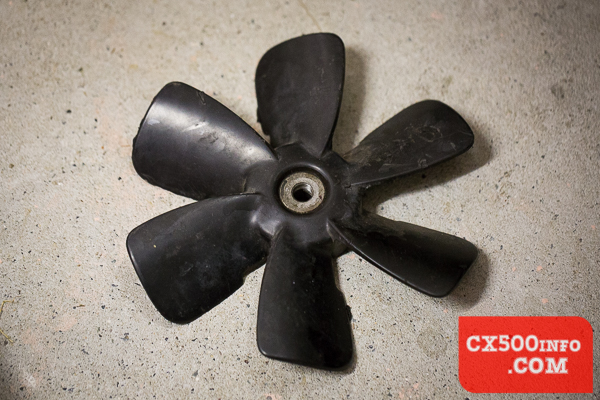
The fan consists of a central aluminium hub, surrounded by six black plastic fins. It’s fairly light at 236 grams. The part number is 19040-MA1-000 and you can still find new ones on eBay. Previous part numbers include 19040-415-010 and 19040-415-020. What do the numbers mean? Read up on how to interpret the Honda product codes. The hub consists of a thread on one side – the side which faces the front wheel, away from the engine:
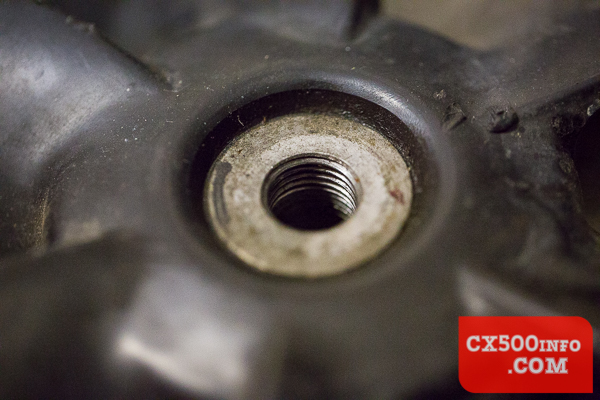
The thread is M14x1.5 – it’s a common size for sump drain bolts if you need to pick one up to get the fan off with. Make sure that the bolt has a flat end, not domed, as you want good, even contact with the camshaft. This large thread is not used to secure the fan to the camshaft – it’s for removing the fan. The fan is actually held onto the camshaft by a taper in the other side of the hub:
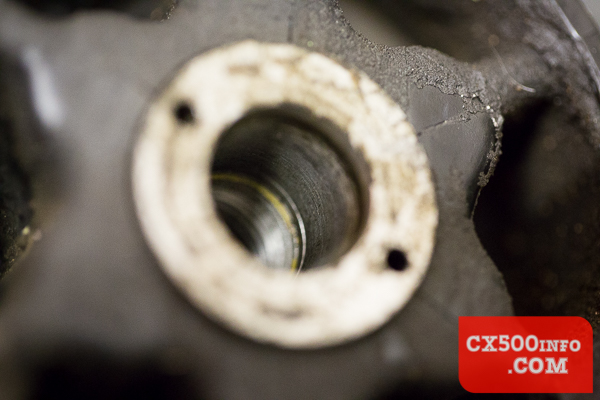
This smooth, tapered surface mates with the camshaft’s matching tapered end:
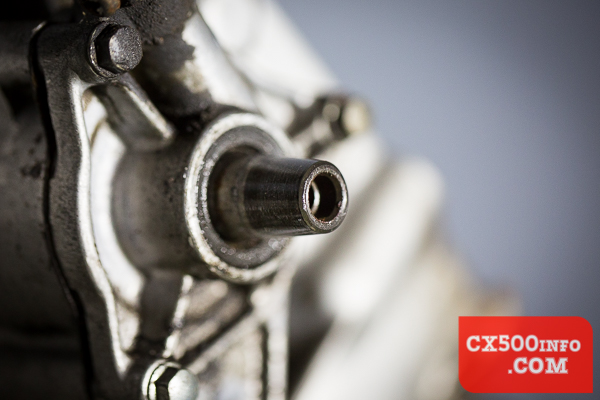
You can see the hole in the end of the camshaft – though you can’t see the threads – where the bolt which keeps the fan in place threads into. Note that the bolt there is only torqued to 14-18ft/lbs – it’s not designed to hold the fan in solely, the tapered press fit should do that. The 8x25mm flange bolt used here is part number 95701-0802500 (eBay) – previously 95700-0802500 – and the washer beneath it is part number 90509-642-000 (eBay
).
If you are re-installing the fan you need to make sure that the end of the camshaft and the inside of the hub are clean to ensure a proper fit. It’s also a good idea to use threadlocker (eBay) on the bolt – it’s not something you want backing out mid-ride and causing your fan to spiral into the back of your radiator.
Looking closely at the rear of the fan (tapered hole side), we can see evidence of a very common issue with these fans – cracks in the hub:
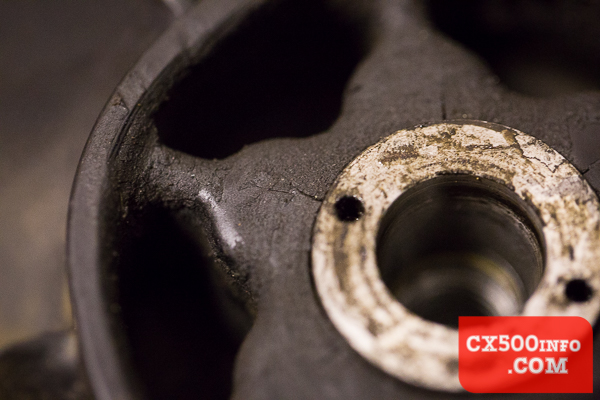
Wipe the grease away to get a better look:
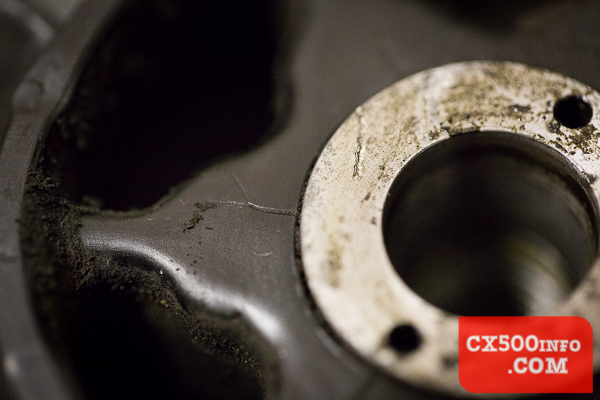
Small cracks in the plastic. Some theorize that this is due to over-torquing the retaining bolt, others suggest that it’s a design weakness. Mind you, 30+ years is probably outside of the expected lifespan for just about any of the plastic components so it’s not really surprising to see some fatigue and failures. Cleaning up the rest of the back of the fan shows more cracks:
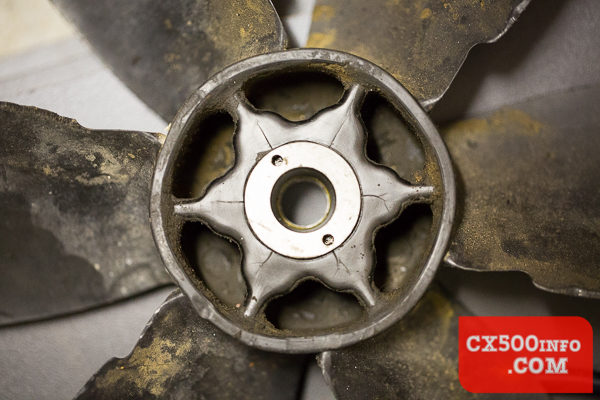
This particular fan is 34 years old this year. A close look at one of the cracks – nearly all the way to the edge:
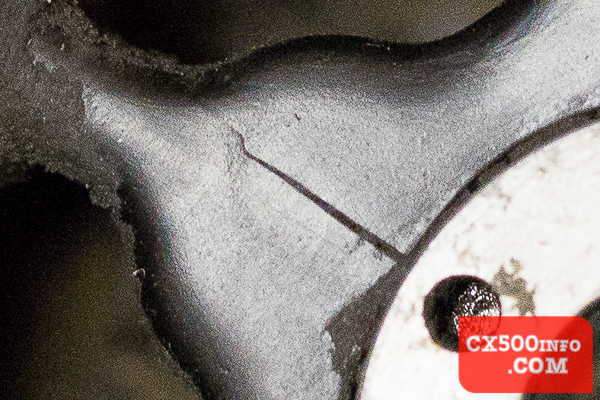
I wouldn’t re-use this one – either do an electric fan conversion or find a new replacement fan. The time and money lost by having the plastic crack all the way through at X,000 RPM and shredding the rear of your radiator is something to avoid if possible!
To remove the fan from the camshaft, undo the retaining bolt, clean up the visible threads, spray some penetrant fluid into the hole and insert a 2″ M14x1.5 bolt. As you tighten the bolt, it will bottom out against the end of the camshaft and push the threads away from the shaft, causing the fan to pop off the end of the can shaft. Theoretically. Here’s a diagram that might help make sense of it:
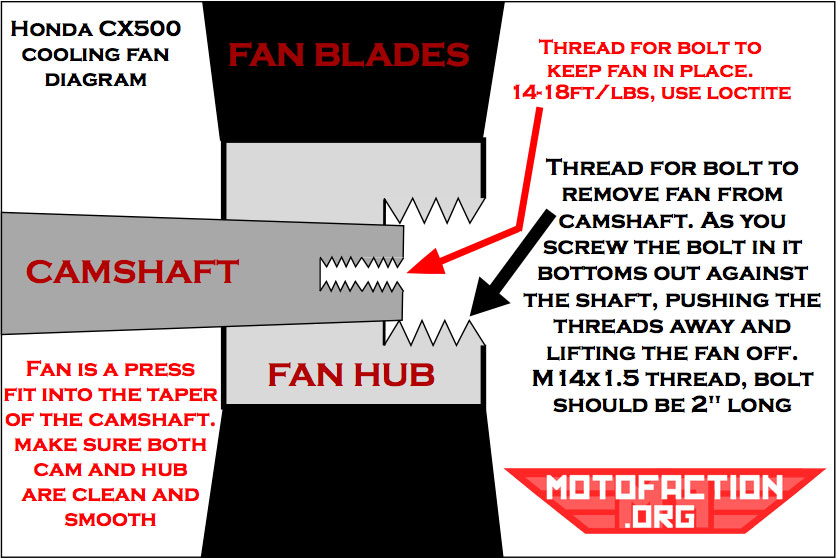
It’s quite common for the fan to be firmly stuck on; if this is the case, more penetrant and some light taps on the end of the bolt with a hammer can help. Don’t use the front axle, despite the fact that it has the correct thread – the end of the axle is tapered and not all of the threads will engage fully, which might result in thread damage. A drain bolt of the correct thread is cheap and available readily from any of the local auto stores that I have checked – better save your axle.
If you have a fan which is crack-free check that there is no movement between the plastic and the metal hub either side to side or back to front; if the plastic is starting to come away you may either end up with a separated cooling fan which isn’t spinning or a ruined radiator, neither of which is convenient.
When you put the retaining bolt in, please use a torque wrench! As mentioned above, too much torque and you may well crack the plastic, too little and it may back off causing the fan to fall off.
While the mechanical fan may have seen out 30+ years of service in a lot of ways it’s not really ideal; when you’re idling in hot, start-stop traffic you may require a fast fan speed to keep temperatures in the healthy range. With the fan speed being tied directly to the engine speed, you’re stuck at a slow setting. Additionally, if you’re blasting along at highway speeds you may not need fan assistance to have enough airflow through the radiator to keep the engine cool; in this situation your fan is dragging on the camshaft by spinning at ~5,000RPM unnecessarily. While a properly functioning thermostat/cooling system should be able to cope with most of these situations, it’s definitely not an ideal setup. Having said that, for every electric fan conversion there are plenty more mechanical fans still running in CX500s out there so whether you take the viewpoint of the change being an improvement or unnecessary, you’ll find people to support your position.